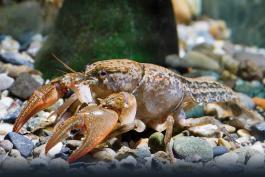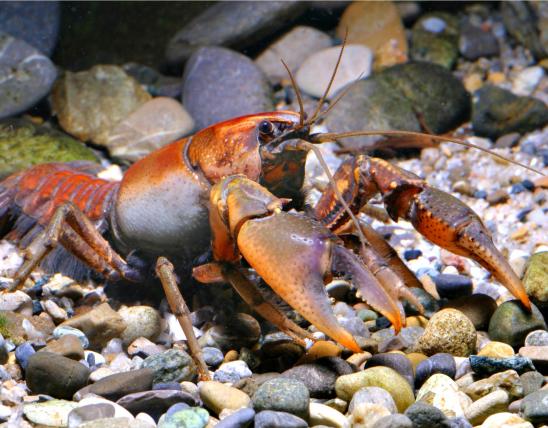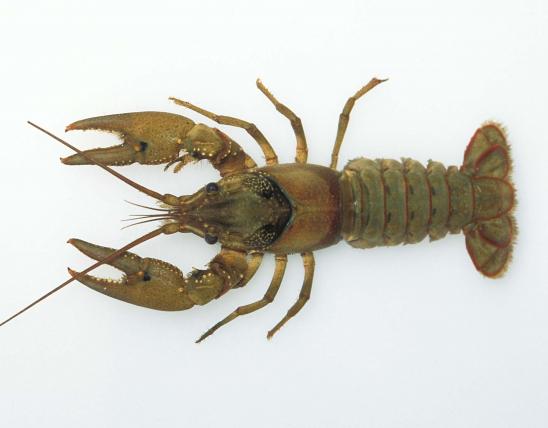
The digger crayfish is a heavy-bodied, reddish-tan species with a pale, iridescent stripe along the midline of the abdomen and short, broad pincers. The moveable finger on the pincers has a deep notch on the inner margin near the base, and there is a thick growth of hairlike setae along the opposing margin of the fixed finger. Areola absent. The rostrum is broad, with a central troughlike depression. The carapace and abdomen are about equal in length.
Similar species: The devil crayfish lacks the notch on the moveable finger. The grassland crayfish lacks the pale iridescent abdominal stripe, and its carapace length is distinctly less than the length of the abdomen.
Adult length: about 1¾ to 3½ inches.

Known from a few localities along the boundary between our southeastern lowlands and the adjacent Ozarks, including Ripley and Butler counties, and from a widely separate location along the lower Gasconade River. It might be more widespread in eastern Missouri, however.
Habitat and Conservation
In Missouri, the digger crayfish occurs in seasonally flooded areas in lowlands and in floodplains of streams. In January through May, it may be found in surface waters, but the rest of the year is spent in burrows underground. Burrows consist of a nearly vertical shaft that extends as low as groundwater. It widens at the bottom, and often there is at least one side passage leading to the surface or to a nearby stream or ditch. The surface openings often have a chimney or mound made of the excavated mud.
Food
Food consists of plant fragments, especially grass seeds, and a variety of animal material, including insect fragments and crayfish parts. At times of high humidity, especially during and after warm rains, these crayfish sit at the entrance of their burrows or wander over the surface of the ground, searching for food, mates, or a new living area.
Status
A species of conservation concern in Missouri, known from only a few localities in our state. Because of its burrowing habit, it is not easily collected, so it might be more widely distributed than researchers have been able to determine. This species occurs along the Gulf Coast from east Texas to the Florida panhandle and north in the Mississippi and Ohio river valleys to the southern Great Lakes in Ontario and Michigan. It also occurs along the Atlantic Coast from Maryland to South Carolina.
Life Cycle
Breeding occurs in late spring or early summer, and mature females carry eggs in the fall. The young hatch in spring, or possibly in fall or early winter. Researchers in Arkansas found that females seem to be about twice as abundant as males, as adults. Collections of juveniles revealed even more lopsided ratios (30 females to 1 male, in an Arkansas collection, and 36 to 2, in a Missouri collection). No one is sure how this unbalanced sex ratio comes about, or what adaptive purpose it serves.
Human Connections
In addition to feeding many types of wildlife, crayfish provide food for many species that humans hunt and fish. Crayfish are fascinating, colorful creatures and are part of our rich native heritage.
Ecosystem Connections
Crayfish are an important link in the food chain between plants and other animals, breaking down plant materials that are resistant to decay. Crayfish in turn are an important food for many other animals. Burrowing animals mix the soils, increasing its fertility.



























